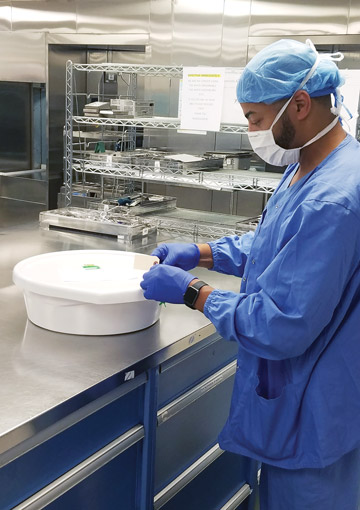The essential elements of proper endoscope care begin well before the notoriously difficult-to-clean devices are ready for high-level disinfection. The following protocols that we established for transporting scopes from bedside to the reprocessing room and back again will lower cross-infection risks and eliminate all doubts about whether a scope is clean or dirty.
1Easy identification
Let's begin with a clean scope leaving the decontamination area. Have staff lock the transport container with green clips and attach a green "Clean" sticker on the outside. If you have the capability, tag each container with a unique ID that can be scanned into an instrument-tracking database. Our scopes are equipped not only with a real-time location system (RTLS) that lets us track location, but also a unique radio frequency information device (RFID) that tracks that the validated cleaning process has occurred.
Note on the outside of the transport container the type of scope that's inside. If a staff member in a procedure room finds a scope inside the container that's different than what's noted on the container, the scope must be reprocessed. If the right scope is inside, but the transport container doesn't have green clips, or is unlocked, the scope must be considered dirty and sent back for reprocessing.
If the container is locked with green clips, the staff member should peel off the green sticker to reveal, underneath, a red biohazard sticker. When the procedure is done and pre-cleaning is performed, the dirty scope is placed right back in that transport container, which already identifies it as dirty. Red biohazard locks are affixed to the container.
There's another safeguard on the scope itself. Have reprocessing techs attach a white "Clean" tag with the completed processing paperwork over the scope's control head or user end port. Again, if the paperwork doesn't have a white "Clean" tag attached, a staff member should automatically deem the scope dirty and not for use, and send it back to the decontamination area for reprocessing.
2Hard stops
Before the procedure begins, the nurse or tech, scope and reprocessing form in hand, should say, "I have a [type of scope] that's been cleaned and high-level disinfected." The proceduralist says, "I agree" (or something similar). The team confirms the scope's model and serial number, verifying with the attached paperwork that it has been cleaned and high-level disinfected. After agreement, the "Clean" white tag attached to the scope is removed. In the EMR, the nurse documents the serial number, model number and confirmation by the team as "Ready for Use." A laminated reminder to perform this hard stop should be posted in procedure rooms.
.svg?sfvrsn=be606e78_3)

.svg?sfvrsn=56b2f850_5)